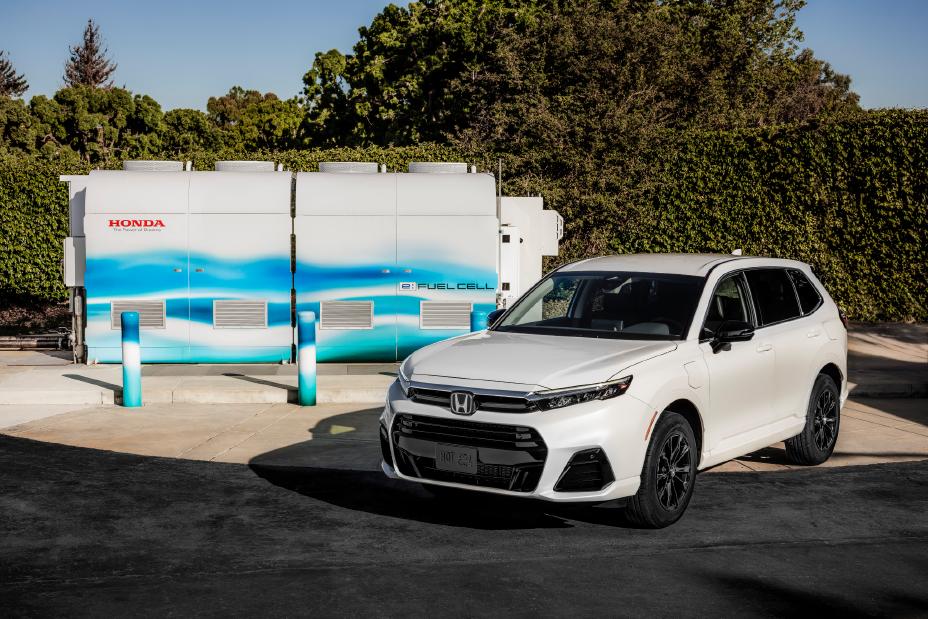Honda’s widespread CR-V compact crossover is now getting a hydrogen-powered plug-in hybrid model that may start deliveries this yr in California – the automotive permits you to recharge through Degree 2 charging for fast journeys, or depend on hydrogen energy for lengthy hauls.
Californians can drive the upcoming 2025 mannequin through lease-only, and Honda is dubbing the brand new setup the less-than-catchy CR-V e:FCEV. However what makes this automotive completely different from a traditional FCEV is that it comes outfitted with a 17.7-kilowatt-hour battery that may be powered by electrical energy generated by hydrogen through the gasoline cell stack or by plugging in to electrical energy. Complete EPA-rated vary is 270 miles, and it may well additionally plugged right into a Degree 2 charger and run on electrical energy for a 29 miles in EV mode.
California-only gasoline cell PHEV
Honda is aiming for a low-volume manufacturing cycle on the automotive, of solely about 300 autos per yr. A choose group of California sellers who full coaching on the car can lease and repair it – and most probably Honda is concentrating on the sellers who nonetheless service the Honda Readability Gas Cell, which offered in California from 2015 to 2021. Why California? Effectively, it’s a great testing floor for brand new tech, and since the state is dwelling to the one hydrogen refueling stations discovered within the US, apart from a pair alongside the East Coast.
Curiously, Honda isn’t placing funding into increasing hydrogen refueling infrastructure, with its final massive transfer being 10 years in the past when it invested $13.8 million to assist constructing further hydrogen stations with FirstElement Gas, experiences Automotive Information.

Nonetheless, Honda is conserving hope alive, and is utilizing the clear tech in energy stations and development equipment in addition to business and retail autos.
The specs
The CR-V e:FCEV is the primary automotive to make use of the Japanese model’s second-gen gasoline cell module, codeveloped by Common Motors and assembled in Michigan.
The car, which shall be out there in a single trim, makes use of a front-mounted single-motor with 174 hp and 229 pound-feet of torque. Max energy output is an estimated 92.2 kilowatts. Honda says the car has a miles-per-gallon equal of 61 miles in city driving, 52 on the freeway, and 57 mixed. To match, the usual CR-V with a front-wheel drivetrain and 2-liter hybrid engine has an estimated vary of 43 mpg within the metropolis, 36 on freeways, and 40 mixed, in accordance with Automotive Information.
Whereas pricing continues to be unknown, the CR-V e:FCEV shall be assembled at Honda’s manufacturing unit in Marysville, Ohio. The Touring mannequin, its solely out there possibility, comes with normal options that embrace 10.2-inch digital instrumentation, 9-inch HD touchscreen, wi-fi Apple CarPlay and Android Auto compatibility, wi-fi telephone charging, a 12-speaker Bose premium audio system, power-adjustable heated entrance seats, heated steering wheel, dual-zone local weather management, parking sensors, and seat upholstery made out of bio-based leather-based.
Virtually zero infrastructure
Kia-owner Hyundai – which like Honda, definitely isn’t in a giant rush to go carbon impartial – can also be among the many very small group of firms embracing hydrogen gasoline cell know-how. The corporate plans to rely closely on hydrogen gasoline cells generated from plastic, meals, and natural waste to energy a complete new era of EVs, from passenger vehicles to heavy-duty vehicles.
Hyundai has already been mass-producing hydrogen gasoline cell EVs for some time with its Nexo line. Presently the 2024 Hyundai Nexo compact crossover and the Toyota Mirai sedan are the one two hydrogen gasoline cell (FCEV) EVs in the stores within the US, and that’s solely in California.
Downside is, there’s nowhere to refuel them. China has the most important community of recharging stations on the earth, however in California, you’ll discover round 63 recharging stations, principally round Los Angeles and San Francisco – much less so now that this month Shell Oil closed seven of its hydrogen fueling stations for passenger vehicles in California, which accounts for about 12% of the overall stations within the US. On the East Coast, there are perhaps a handful of stations.
Storing hydrogen is a problem too in that it requires excessive pressures, low temperatures, or different chemical processes to maintain it compact.
Nonetheless, Honda is seeing hydrogen as a necessary piece of its puzzle to get to carbon neutrality – by the very faraway goal of 2050. However it says that BEVs and gasoline cell EVs will signify 100% of its car gross sales by 2040.
Pictures: Courtesy of Honda
Should you’re an electrical car proprietor, cost up your automotive at dwelling with rooftop photo voltaic panels. To ensure you discover a trusted, dependable photo voltaic installer close to you that gives aggressive pricing on photo voltaic, try EnergySage, a free service that makes it simple so that you can go photo voltaic. They’ve a whole lot of pre-vetted photo voltaic installers competing for your small business, making certain you get top quality options and save 20-30% in comparison with going it alone. Plus, it’s free to make use of and also you gained’t get gross sales calls till you choose an installer and share your telephone quantity with them.
Your personalised photo voltaic quotes are simple to check on-line and also you’ll get entry to unbiased Power Advisers that can assist you each step of the best way. Get began right here.